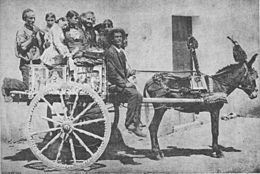
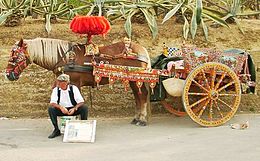


The Sicilian cart (or carretto siciliano in Italian and carrettu sicilianu in Sicilian or carretti (plural)) is an ornate, colorful style of horse or donkey-drawn cart native to the island of Sicily, in Italy.




The Sicilian cart (or carretto siciliano in Italian and carrettu sicilianu in Sicilian or carretti (plural)) is an ornate, colorful style of horse or donkey-drawn cart native to the island of Sicily, in Italy.
The carts were used for the transportation of goods throughout the island from the 19th to the 20th century. Carts reached the height of their popularity in the 1920s, when many thousand were on the island. Miniature carts, or Carrettini Siciliani, are often sold in Sicily (or in Italian shops and restaurants in other countries) as souvenirs. There are several museums dedicated to the carts in Sicily: one in Terrasini, in the province of Palermo, and one in Aci Sant'Antonio, in the province of Catania.
Sicilian wood carver George Petralia states that horses were mostly used in the city and flat plains, while donkeys or mules were more often used in rough terrain for hauling heavy loads. [1] The cart has two wheels and is primarily handmade out of wood with iron metal components. Carts called "Carretti da Lavoro" (carts for work) are used for hauling miscellaneous light loads such as produce, wood, wine, and people, and "Carretti da Gara" are carts for festive occasions such as weddings and parades. The Carretto is like the 'taxi' or 'truck' of today. [2]

In modern-day Sicily, the tradition continues in small, three-wheeled motorized vehicles (called Ape), which can be found painted in the traditional way.
The crews that built carretti included woodcarvers, metal workers, and painters. The woodcarvers carved the many panels that were often historic reliefs. The metal workers worked the iron, in a 'ferro battuto' style, which included highly decorated metal undercarriages.
The Sicilian Carretto is made in several provinces in Sicily each with their own style. Carretti made in the province of Palermo have more of a square box design, those made in Catania are made with more elaborate 'keys', and then there are the carts made in Agrigento which have their own distinctive style. [2]

The craft of making the carts is handed down from generation to generation, through the training of apprentices. Carts are known for being covered in carvings and brightly painted scenes from Sicilian history and folklore as well as intricate geometrical designs. These scenes also served the purpose of conveying historical information to those who were illiterate. The colors of Sicily's flag, yellow and red, feature prominently on the carts, along with details in bright blues and greens. The animals pulling the carts are often elaborately adorned as well.

Sicily is the largest and most populous island in the Mediterranean Sea and one of the 20 regions of Italy. It is one of the five Italian autonomous regions and is officially referred to as Regione Siciliana. The island has 4.8 million inhabitants. Its capital city is Palermo. It is named after the Sicels, who inhabited the eastern part of the island during the Iron Age.
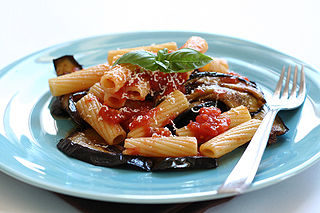
Sicilian cuisine is the style of cooking on the island of Sicily. It shows traces of all cultures that have existed on the island of Sicily over the last two millennia. Although its cuisine has much in common with Italian cuisine, Sicilian food also has Greek, Spanish, French, Jewish, and Arab influences.

Sicilian is a Romance language that is spoken on the island of Sicily and its satellite islands. It belongs to the broader Extreme Southern Italian language group.

Petralia Sottana is a town and comune in the Metropolitan City of Palermo, in the island of Sicily, Southern Italy. The main characters in Emanuele Crialese's 2006 film of Sicilian immigration to America, Nuovomondo, come from the town of Petralia.

The province of Palermo was a province in the autonomous region of Sicily, a major island in Southern Italy. Its capital was the city of Palermo. On 4 August 2015, it was replaced by the Metropolitan City of Palermo.
The music of Sicily is created by peoples from the isle of Sicily. It was shaped by the island's history, from the island's great presence as part of Magna Grecia 2,500 years ago, through various historical incarnations as a part of the Roman Empire, then as an independent state as the Emirate of Sicily then as an integral part of the Kingdom of Sicily and later the Kingdom of the Two Sicilies, and, finally, as an autonomous region of the modern nation state of Italy.

Sebastiano "Nello" Musumeci is a right-wing Italian politician. Musumeci is serving as Minister for Civil Protection and Maritime Policies since 22 October 2022 in the government of Giorgia Meloni. He previously served as president of Sicily from 18 November 2017 until 13 October 2022.

Sicilian Baroque is the distinctive form of Baroque architecture which evolved on the island of Sicily, off the southern coast of Italy, in the 17th and 18th centuries, when it was part of the Spanish Empire. The style is recognisable not only by its typical Baroque curves and flourishes, but also by distinctive grinning masks and putti and a particular flamboyance that has given Sicily a unique architectural identity.
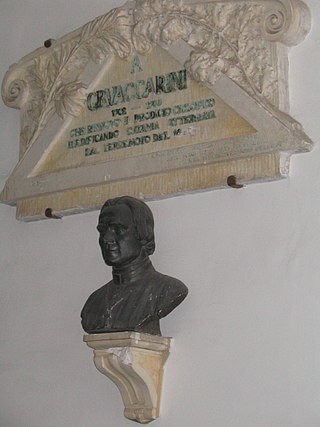
Giovanni Battista Vaccarini was a Sicilian architect, notable for his work in the Sicilian Baroque style in his homeland during the period of massive rebuilding following the earthquake of 1693. Many of his principal works can be found in the area in and around Catania.

Cassata or cassata siciliana is a traditional cake from Sicily, Italy. Cassata is typically composed of a round sponge cake moistened with fruit juices or liqueur and layered with ricotta cheese and candied fruit. Cassata has a shell of marzipan, pink and green coloured icing, and decorative designs. Cassata may also refer to a Neapolitan ice cream containing candied or dried fruit and nuts.

The Fasci Siciliani, short for Fasci Siciliani dei Lavoratori, were a popular movement of democratic and socialist inspiration that arose in Sicily in the years between 1889 and 1894. The Fasci gained the support of the poorest and most exploited classes of the island by channeling their frustration and discontent into a coherent programme based on the establishment of new rights. Consisting of a jumble of traditionalist sentiment, religiosity, and socialist consciousness, the movement reached its apex in the summer of 1893, when new conditions were presented to the landowners and mine owners of Sicily concerning the renewal of sharecropping and rental contracts.
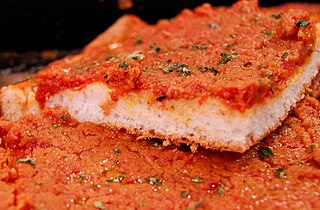
Sicilian pizza is a pizza prepared in a manner that originated in Sicily, Italy. Sicilian pizza is also known as sfincione or focaccia with toppings. This type of pizza became a popular dish in western Sicily by the mid-19th century and was the type of pizza usually consumed in Sicily until the 1860s. It eventually reached North America in a slightly altered form, with thicker crust and a rectangular shape.
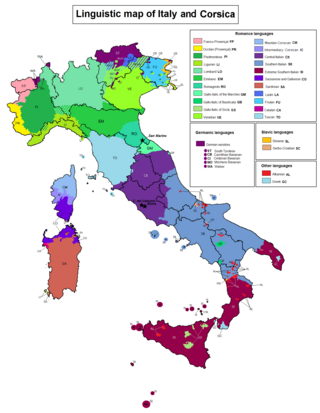
Gallo-Italic of Sicily is a group of Gallo-Italic languages found in about 15 isolated communities of central eastern Sicily. Forming a language island in the otherwise Sicilian language area, it dates back to migrations from northern Italy during the reign of Norman Roger I of Sicily and his successors.
The Derby di Sicilia or Sicilian Derby in English, is a local derby between Italian football clubs Catania FC and Palermo FC. Catania and Palermo are the two main cities on the island of Sicily, and the teams are fierce rivals. However, they have seldom played each other within the Italian football league system, because in many seasons they have played in separate divisions of the league. The first time the Sicilian derby took place in the context of league football was on November 1, 1936, at Palermo in Serie B level; it ended in a 1–1 draw. The Sicilian derby has been played 10 times in Serie A: Catania leading their rivals by 5 victories to Palermo's 4; the other occasion was drawn. The teams have also met in local Sicilian competitions, and friendly matches.
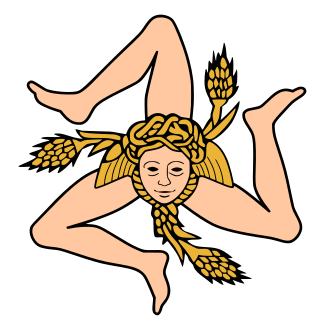
The Movement for the Independence of Sicily was a separatist Sicilian political party originally active in Sicily from 1943 to 1951. Its best electoral result was in 1947, when it won 8.8% of the votes in the Sicilian regional election and had nine regional deputies elected.

The Opera dei Pupi is a marionette theatrical representation of Frankish romantic poems traditionally performed in Sicily, Italy.

The Metropolitan City of Palermo is a metropolitan city in Sicily, Italy. Its capital is the city of Palermo. It replaced the province of Palermo and comprises the city of Palermo and other 82 comuni.
Credito Siciliano was an Italian bank headquartered in Acireale, Sicily and previously Palermo. It was a subsidiary of Credito Valtellinese until its merger by incorporation into Credito Valtellinese in June 2018.
Banca Popolare Sant'Angelo S.C.p.A. is an Italian cooperative bank based in Licata and Palermo, the capital of Sicily. The bank also has one branch in Lampedusa, the south most island of Italy and also has a branch in Rome.
Sicilian orthography uses a variant of the Latin alphabet consisting of 23 or more letters to write the Sicilian language.